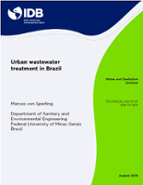Urban Wastewater Treatment in Brazil
Date
Aug 2016
EDITOR
Perroni, Alejandra
The major focus of this report is the description and critical analysis of the main wastewater treatment processes used in Brazil. Special emphasis is given to small to medium size communities with populations lower than 100,000 inhabitants, which represent approximately 95% of the 5,570 Brazilian municipalities. In terms of coverage, around 40% of the sewage generated in Brazil is treated, with an estimated number of treatment plants in the order of 2,800. Based on a survey of 2,187 treatment plants, the configurations most widely adopted are: anaerobic pond followed by facultative pond; UASB (upflow anaerobic sludge blanket) reactor; activated sludge; ponds followed by maturation ponds; septic tank followed by anaerobic filter. An assessment of the actual performance of 166 treatment plants showed a great variability in the effluent concentrations and in the removal efficiencies, with performances that were usually inferior to those reported in the technical literature. Data on capital cost expendituresindicated values ranging from R$60/inhabitant to R$650/inhabitant, depending on the treatment process employed. Due to the favorable climatic conditions in Brazil, there are no technical limitations for the adoption of biological sewage treatment. Traditional options incorporate stabilization ponds and activated sludge, but the more recent trend involves the adoption of UASB reactors followed by some form of post-treatment.



